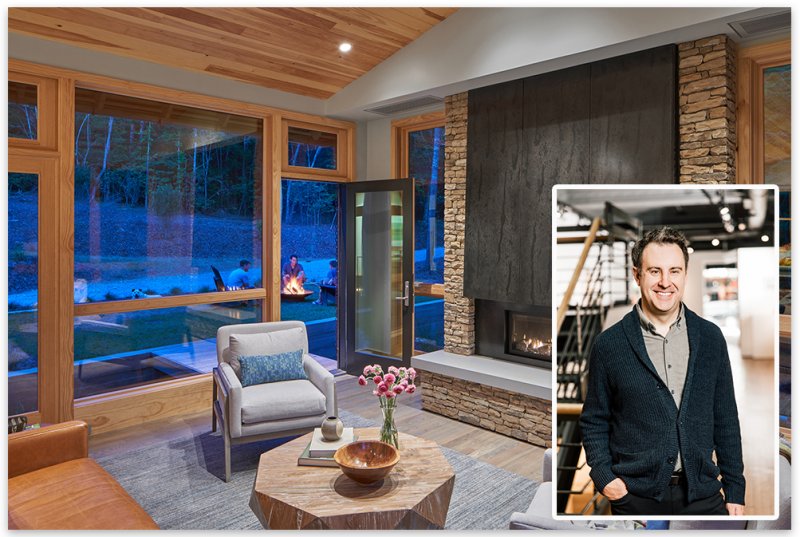Home Schooled
Home Schooled: What’s ahead for home design in 2023
The pandemic has left an indelible impression on so many aspects of culture, and the home and design realm are no exception. With more people working from home permanently, greater concern for the environment, and generational changes, there’s a new spotlight on the home as not just a personal space, but as part of the larger environment and cultural context.
Ideally positioned to observe these changes is Altura Architects, the firm known for thirty-eight years as Samsel Architects, one of the premier forces in home design in Asheville. Reflecting firm founder Jim Samsel’s retirement several years ago, the group debuted a new name in January. Nathan Bryant, one of the firm’s principals (along with Duncan McPherson) and vice president, shares with us his perspective on emerging trends in architecture, home building, and design in Western North Carolina, highlighting what’s happening now and what’s here to stay.
Bringing the Outdoors In
Organic materials (such as wood and natural stone), floor-to-ceiling retractable windows and doors, custom planter boxes—these are just a few of the ways that homeowners are bringing the outdoors in. The trend, which began in 2020, shows no signs of stopping.
“Connectivity to the outdoors is something that’s always been important to our studio, and we’re seeing more people value that fresh air component, especially considering how fresh air was so valued during the pandemic,” says Bryant. “We’re seeing more emphasis on outdoor living spaces like screen porches, courtyards, and patios.”
Home as Sanctuary
More homeowners are seeing a home not as a showpiece, a place to lay one’s head at night, or a “commodity” as Bryant puts it, but as a sanctuary that offers a retreat from the world. The idea that “design and architecture can be restorative to inhabitants,” is taking off, he adds. “We’re seeing clients place a higher value on health and healing than before. Our clients want a home that provides daylight, healthy interior air, and mood-enhancing connection to the outdoors.”
Especially for second homes, a strong emphasis on rest and relaxation is emerging. “Mountain homes have generally been valued as getaway retreats,” Bryant continues. “A retreat has a health and healing objective, a restorative setting that offers greater solitude and connection to nature. These types of secondary homes tend towards a program that is smaller, flexible in use, and casual in nature.” Communing with family and friends is increasingly valued over “entertaining” in a showy sense of the word.
Sustainability
“Sustainability and green building are here to stay,” says Bryant. Architects and builders have always been cognizant of the heavy toll that energy consumption has on the planet, but they have often had to convince their clients to pursue more energy-efficient and low-impact features for their homes, because they sometimes came with a higher price tag. Now, clients have come around. “Building science and technology have advanced greatly,” says Bryant. “It’s our role as architects to present these opportunities and efficiencies to our clients. Energy efficient homes are not only great for the environment but have become important for financial reasons. The mainstreaming of green building opportunities such as solar panels, geothermal energy, and passive solar design has resulted in a savvier client looking for lower energy costs, which can help offset the costs of a new home.” Homes with both a smaller physical footprint and smaller energy footprint are increasingly in demand.
What’s the greenest home? One that already exists, says Bryant. Adding on, restoring, or renovating an existing home will generally be more environmentally friendly than building a new one.
Timeless Design
Classic, modern, or both? More homeowners are looking beyond trends and embracing the “timeless” fundamentals of “proportion, scale, and function,” Bryant says. “The pursuit of trendy designs can equate to short-term, disposable solutions, and with costs inflating, clients are more wary of design investments or upgrades that may not stand the test of time. We view aesthetic timelessness as a key strategy of sustainable architecture.” How does that translate for the homeowner? A home that is centered on quality over trendy materials, thoughtful design, and form that’s grounded in function as well as aesthetics.
Creative Approaches & Smart Spending
The increase in construction costs over the past few years has affected every aspect of the home business. For homeowners, that might mean a dreamed-of feature presents a shock to the budget. But compromise need not mean giving up completely. Byrant says that the deliberate choices that many homeowners are now having to make have led to very creative outcomes.
“Our adjustment to the new norm has required us to change how we prioritize when we design a home,” he says. When it comes to spending, though, Bryant says, homeowners are choosing to invest in their homes over other investments.
Long-Term Use
Yes, we are looking at trends. But one of the biggest trends is to think beyond the trends and plan for a home’s long-range future. In the same way that fast fashion is on the way out, replaced with investment in quality pieces, homeowners are thinking beyond their immediate needs.
“We’re seeing greater emphasis on the adaptability of a house over the long term, more consideration of how a family’s use of a house might evolve over time,” says Bryant. “Clients are viewing their new home as a multi-generational investment and are looking to make their home ‘their own’ and not worrying as much about conventional features or resale. For instance, we’ve seen a lot of people forgoing formal dining rooms, wanting dual-purpose spaces, and generally valuing quality over quantity.”
